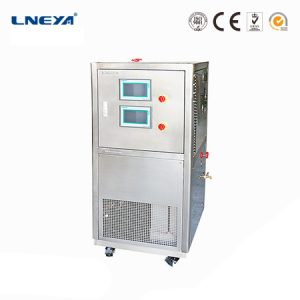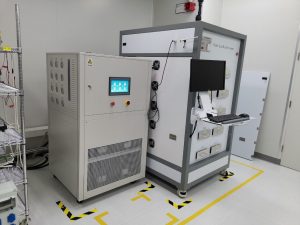Specific conditions of high and low temperature test of EV (electric vehicle) battery
There are mainly 2 types of vehicles:
1. Battery for pure electric vehicle
2. Fuel cell, dedicated to fuel cell electric vehicles
Thermal test: This test is performed to characterize the reaction of cells to the high-temperature environment.
a) Adjust the SOC of battery to 100% of BEV application and 80% of HEV application.
b) Batteries stabilized at room temperature shall be placed in a gravity or circulating air convection oven. The oven temperature shall be raised to 130 ℃ ± 2K at the speed of 5K/min. The battery shall be held at this temperature for 30 minutes before stopping the test.
Temperature Cycle Test:
This test is conducted to characterize the thermal durability of the battery by alternately exposing it to low and high temperatures to cause expansion and contraction of the battery components.
a) Adjust the SOC of battery to 100% of BEV application and 80% of HEV application.
b) Conduct temperature cycling according to ISO 16750-4. As shown in Table 4, the ultra-low operating temperature shall be – 40 ℃ or Tmin specified by the battery manufacturer, and the maximum operating temperature shall be 85 ℃ or Tmax specified by the battery manufacturer. Perform 30 test cycles as specified.
The battery shall be heated in a gravity convection or circulating air oven with an initial temperature of 20 ± 5 ° C (68 ± 9 ° F). The temperature of the oven is raised to 130 ± 2 ℃ (266 ± 3.6 ℉) at the rate of 5 ± 2 ℃ (9 ± 3.6 ℉) per minute and maintained for 10 minutes. The sample shall be returned to room temperature (20 ± 5 ℃) and then checked. For batteries with a set temperature higher than 100 ℃ (212 ℉), the regulating temperature shall be increased from 130 ± 2 ℃ (266 ± 3.6 ℉) to 30 ± 2 ℃ (86 ± 3.6 ℉) from the manufacturer’s maximum specified temperature. For lithium metal chemical battery, the regulating temperature shall be increased to 170 ± 2 ℃ (338 ± 3.6 ℉) at most.
The above contents are excerpts from the network. Please contact us if you have any questions.
Related recommendations
-
Refrigeration effect of water-cooled chiller at -15℃
851The main configurations of water-cooledchillers are: compressors, electrical components, water pumps, evaporators,condensers, high/low pressure controllers, high/low pressure gauges, LCDthermostats, expansion valves, antifreeze switches, hand v...
View details -
New energy shaft cooling chiller
820New energy shaft cooling does not necessarily require industrial freezers, but is usually achieved using industrial chillers or cooling systems. Industrial freezers are mainly used for extremely low temperature freezing and processing, w...
View details -
Closed Refrigeration Heating Circulator Daily Maintenance Manual
1332The closed refrigeration and heating circulators of different manufacturers have a certain life span. Reasonable and correct operation and maintenance of the closed refrigeration heating circulator can effectively extend the service life. The user...
View details -
Ways to make ultra-low temperature circulating chillers more energy-efficient
765In modern times, environmental protectionand energy saving is the development theme, so is the industrial chiller. Then,how to improve your industrial chiller to be more energy conservation? First, to prevent and reduce the pipescaling of ult...
View details
 LNEYA Industrial Chillers Manufacturer Supplier
LNEYA Industrial Chillers Manufacturer Supplier














